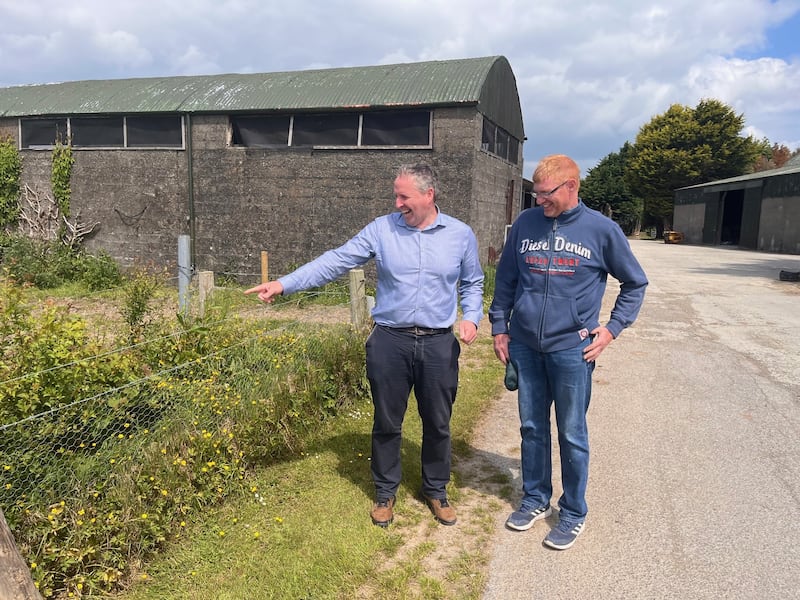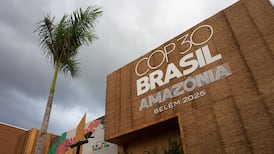Operating a high-tech “climate neutral” farm in rich dairying country near Bandon, Co Cork – where the 250 cows wear special GPS health monitoring devices – might seem like an attempt to fashion the ideal Irish farm of the future with little tie-in with current reality.
The 250-acre Shinagh farm is a key focus of the FarmZeroC project, a collaboration between BiOrbic, the Carbery Group and others to develop more sustainable farming.
Looking at the scientists, energy specialists and biodiversity experts whose input is crucial to running the farm, it could be a recipe for inefficient farming by committee. However, results don’t lie.
“The ambition is to develop a ‘climate-neutral’ dairy farm. The original ambition was to be ‘carbon neutral’. But we pivoted pretty quickly because we realised that was too narrow,” says Enda Buckley, director of sustainability at the Carbery Group. “It’s very much a holistic approach. It’s not just the focus on carbon, we’re looking at water quality, air quality ... biodiversity is a big part of the project.”
READ MORE
Prof Kevin O’Connor, director of the Science Foundation Ireland (SFI) BiOrbic project, was doing work for Carbery and alerted him about a SFI “zero emissions challenge” – a competition for breakthrough decarbonisation projects. They realised nobody had pursued the idea of a climate-neutral farm.
“We won the challenge, which was transformative. That was €2 million in funding,” Buckley says.
The FarmZeroC project came into being with BiOrbic, a national collaboration of researchers focused on the development of a sustainable, circular bioeconomy based in UCD, as its main scientific partner.
The thrust of the operation of Shinagh farm may be new technologies but interventions must be adoptable on a standard farm. “It’s all about resilience and at the same time ensuring there is money to be made from this as well because, ‘you can’t be green if you’re in the red’,” Buckley notes.
Shinagh farm was acquired in 2011 by a group of west Cork Co-ops, including Carbery. With abolition of milk quotas looming, they were keen to attract younger farmers into the space. They wanted to set up “a low-input farm with low set-up costs”, which was achieved in collaboration with Teagasc. Emphasis was on profitability and optimising the grass-based system.
FarmZeroC came on board in 2018, extending focus to sustainability.
A network of nearby “monitor farmers” was established to enable new processes to be rolled out quickly.
[ Project that aims to make 5,000 dairy farms climate neutral awarded €2 millionOpens in new window ]
Among early adopters was John Cullinane, whose farm is 15 minutes away from Shinagh. He says farmers are reluctant to adopt new technology unless they see another farmer deploying it, “and it’s actually working. That’s where we come in.”
Monitor farmers meet regularly and host farm walks. They check in with farm manager Kevin Aherne on what’s happening at Shinagh. Cullinane is motivated by knowing something can be done, especially in bringing tech-savvy, younger farmers on board, and showing his family there are good options. “It’s about giving something back; it’s not just about hard work.”
He highlights benefits from actions such as wiring off corners of fields for nature. “You let what’s there flourish. It’s not costing and it’s definitely good.”
The driver of progress at Shinagh is a “life-cycle assessment” of the farm. It means processing an array of data, especially sources of greenhouse gases that determine the carbon footprint. Developed by analysts from UCD, this environmental accounting covers emissions, cattle numbers, manure management including slurry spreading, animal health, grassland, soil and renewable energy.
Walking around the farm, Buckley and Cullinane point to “slightly chaotic” new hedgerows; full of native species – an anathema for farmers wanting tidiness. But that’s now part of “natural capital accounting” for which they will be increasingly rewarded. “Neat is not always best,” Buckley says.
Initially, they did not see the value of setting aside land to become a wetland, now full of diverse plants, insects and birds. That resistance soon dissipated. Output has not been undermined by making 10 per cent of it a natural habitat.
Habitats are mapped using satellites “to show farmers what they have, and how they can make improvements”.
Cows are routinely enticed into a ration feeder and, while chewing the cud, a machine measures their belching of methane. Every cow has an electronic device around its neck that monitors its health and breeding cycle.

Cullinane extols the virtues of the farm’s Jersey-Friesian cross cows, with their long backs and large “forage capacity” offered by large stomachs as if they were thoroughbred horses.
Typically, the cows are smaller but hardier, generating “very high milk solids” – translating into more money for farmers. They are highly efficient “because you get more milk off them in their lifetime”.
The focus, delivery and farmer buy-in contrasts with the public perception of a sector being slow to address its acute methane problem. In its first five years, Shinagh has reduced its carbon footprint by 27 per cent to a third below the national average for dairy farms. “A great story in itself,” Buckley says.
The farm is also maximising sequestration – capturing carbon – showing how it can be done with a mineral soil. Allied to that is impressive efficiency in fertiliser use and success in curbing nitrous oxide and ammonia output. Artificial nitrogen use has been cut by 45 per cent with no impact on production. This is made possible by growing clover and “multi-sward” grass species. Combined with using “protected urea”, it added up to a cut of 42,000 tonnes of carbon dioxide last year.
Buckley accepts, however, it will get more challenging to get the footprint down further.
Natural rumination by cattle is responsible for 52 per cent of emissions. Using a specialised feed supplement for cattle during milking cut methane by 7 per cent. The reduction when cattle are housed indoors over winter is up to 30 per cent.
With biotech company GlassPort Bio, they have successfully trialled a new slurry additive which has seen a 75 per cent reduction in methane output. Slurry causes 8 per cent of the farm’s methane. This, Buckley says, is a “big success”, so they are keen to see it used in other farms.
More long-term projects involve developing new food sources – possibly from beet pulp or rapeseed – to replace imported soya, and using “natural biostimulants” as fertilisers, notably seaweeds.
Shinagh applies the economic breeding index (EBI) to livestock production to maximise the quality of the predominant Jersey Friesan cross breed on the basis that it is more efficient and healthier. Teagasc has shown high EBI cows reduce methane over their lifetime.
With solar and wind capacity on site, the farm is approaching 85 per cent energy self-sufficiency. It has developed a grass biorefinery combined with an anaerobic digester, which shows how versatile grass is as a raw material. Freshly harvested grass produces not only cattle feed and fertiliser, but also an energy source through the biomethane generated by the anaerobic digester process.
The beauty of this system is farmers can still have winter forage for their cows. It is taking off in Denmark but because “no one does grass as good as Ireland”, Buckley predicts it could be a revenue stream for Irish farmers. Department of Agriculture funding from carbon taxes will enable them to build an integrated biorefinery.
Sustainability projects can suffer from “carbon tunnel vision”, says Prof Jane Stout of Trinity College – by just focusing on emissions and increasing carbon efficiency and ignoring sustainability.
“The FarmZeroC project is significant because, despite the name, its environmental ambitions were to not only reduce carbon emissions but to also enhance biodiversity,” she says.
TCD researchers mapped and quantified Shinagh’s biodiversity, using both remote and traditional boots on the ground methods. “With Shinagh farm managers, we co-designed and introduced biodiversity enhancement measures, increasing the biodiversity on the farm, without reducing productivity,” says Stout.
This included introducing multi-species swards; planting hedgerows, reducing mowing and creating wetlands. “We identified additional benefits this biodiversity could deliver for both farmers and surrounding communities in terms of ecosystem services,” she adds.
These benefits included carbon sequestration and storage in woody habitats, pollination services from unmown or wild grassy areas, improved water quality and pollution mitigation from natural habitats, adding up to “a diverse and healthy agro-ecosystem”, Stout says.
“Although Shinagh is a relatively high-tech, intensive farm, all of these biodiversity measurement and enhancement measures are transferable to other farms, and can help farmers reach and exceed habitat and nature restoration targets,” she adds.
Shinagh is embarking on its second phase towards climate neutrality. Buckley hopes its know-how is extended to thousands of farms across the country. Farmer attitudes have changed, he adds, which will enable this to happen, as they see the value of having healthy habitats on their land, which doesn’t impact on production. “Farmers are into this. They really want nature to thrive and flourish.”
- Sign up for push alerts and have the best news, analysis and comment delivered directly to your phone
- Join The Irish Times on WhatsApp and stay up to date
- Listen to our Inside Politics podcast for the best political chat and analysis











